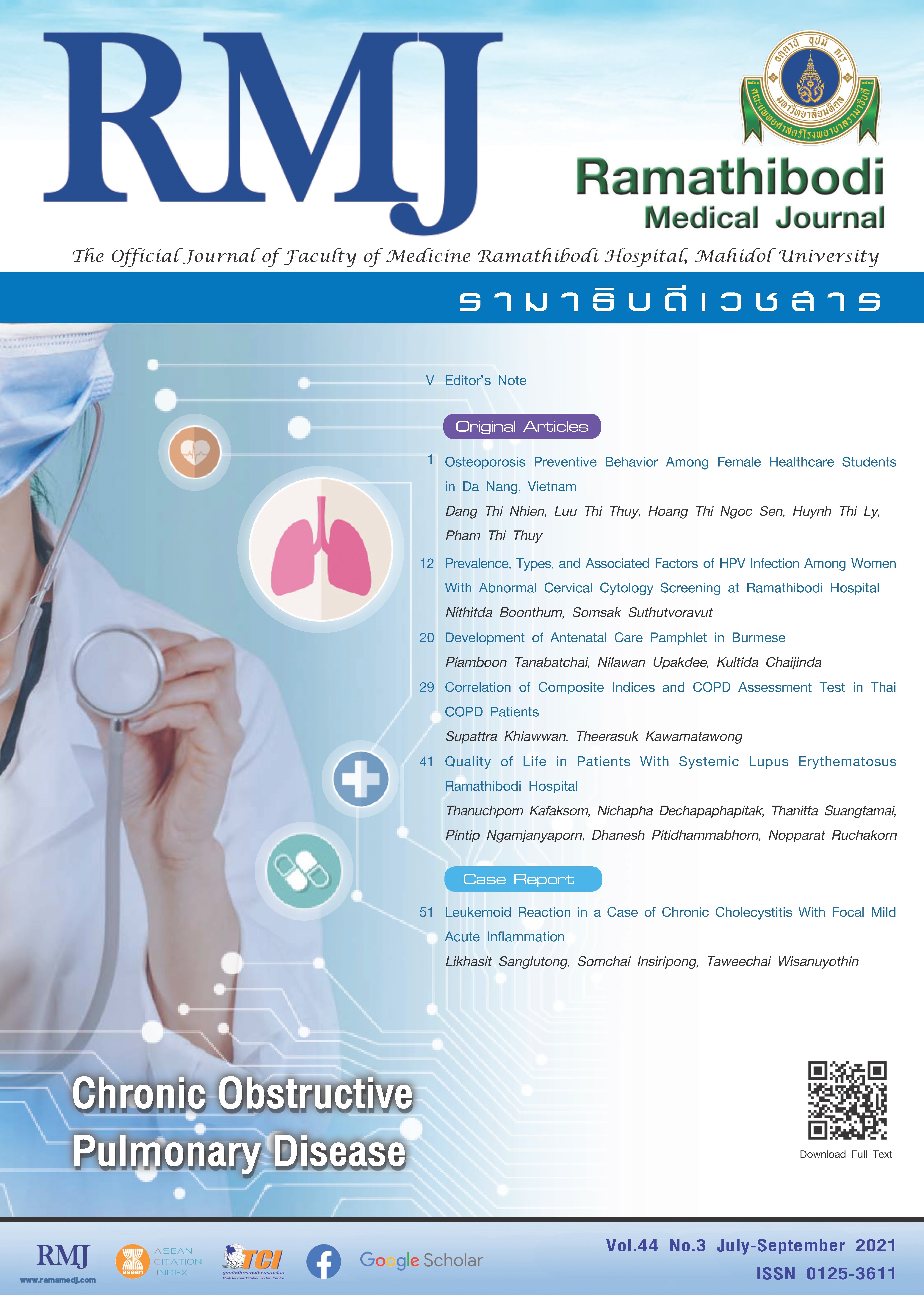Correlation of Composite Indices and COPD Assessment Test in Thai COPD Patients
DOI:
https://doi.org/10.33165/rmj.2021.44.3.242498Keywords:
Chronic obstructive pulmonary disease, COPD assessment test, Composite index, BODE index, Exercise toleranceAbstract
Background: Chronic obstructive pulmonary disease (COPD) is a common preventable and treatable chronic respiratory diseases. The BODE, ADO, DOSE are the composite indices taking into consideration for prognostication. In addition, COPD assessment test (CAT) score is associated with quality of life, taken for assessing symptoms severity and for personalizing treatments.
Objective: To investigate the CAT score in Thai COPD patients according to their BODE, ADO, and DOSE in the influence of clinical parameters and outcomes.
Methods: Medical records were reviewed between January 2016 and December 2016. BODE, ADO and DOSE was calculated based on their individual components.
Results: Total 125 consecutive COPD patients were recruited. There was difference between CAT score among the GOLD stages classified (P = .02). There was significant difference of CAT between 4 BODE quartiles in cohort (P = .001).Thai COPD patients had the higher ADO index exhibit the higher CAT score than those with the lower ADO index (P = .001). There was no difference in CAT score between COPD with the higher and the lower DOSE index (P = .05).
Conclusions: The higher CAT score found in Thai COPD patients with the higher composite indices of BODE and ADO. However, there was no difference in the DOSE index.
References
Osthoff M, Jenkins C, Leuppi J. Chronic obstructive pulmonary disease--a treatable disease. Swiss Med Wkly. 2013;143:w13777. doi:10.4414/smw.2013.13777
Donaldson GC, Seemungal TA, Bhowmik A, Wedzicha JA. Relationship between exacerbation frequency and lung function decline in chronic obstructive pulmonary disease. Thorax. 2002;57(10):847-852. doi:10.1136/thorax.57.10.847
Global Initiative for Chronic Obstructive Lung Disease. Global Strategy for the Diagnosis, Management, and Prevention of Chronic Obstructive Pulmonary Disease. NHLBI/WHO workshop report; 2008. Accessed January 4, 2021. https://goldcopd.org
Jones PW, Harding G, Berry P, Wiklund I, Chen WH, Kline Leidy N. Development and first validation of the COPD Assessment Test. Eur Respir J. 2009;34(3):648-654. doi:10.1183/09031936.00102509
Fletcher CM. Standardized questionnaire on respiratory symptoms: a statement prepared and approved by the MRC Committee on the Aetiology of Chronic Bronchitis (MRC breathlessness score). Br Med J. 1960;2(5213):1665.
Puhan MA, Garcia-Aymerich J, Frey M, et al. Expansion of the prognostic assessment of patients with chronic obstructive pulmonary disease: the updated BODE index and the ADO index. Lancet. 2009;374(9691):704-711. doi:10.1016/S0140-6736(09)61301-5
Jones RC, Donaldson GC, Chavannes NH, et al. Derivation and validation of a composite index of severity in chronic obstructive pulmonary disease: the DOSE Index. Am J Respir Crit Care Med. 2009;180(12):1189-1195. doi:10.1164/rccm.200902-0271OC
Celli BR, Cote CG, Marin JM, et al. The body-mass index, airflow obstruction, dyspnea, and exercise capacity index in chronic obstructive pulmonary disease. N Engl J Med. 2004;350(10):1005-1012. doi:10.1056/NEJMoa021322
Ong KC, Earnest A, Lu SJ. A multidimensional grading system (BODE index) as predictor of hospitalization for COPD. Chest. 2005;128(6):3810-3816. doi:10.1378/chest.128.6.3810
Dijk WD, Bemt Lv, Haak-Rongen Sv, et al. Multidimensional prognostic indices for use in COPD patient care. A systematic review. Respir Res. 2011;12(1):151. doi:10.1186/1465-9921-12-151
Jones RC, Price D, Chavannes NH, et al. Multi-component assessment of chronic obstructive pulmonary disease: an evaluation of the ADO and DOSE indices and the global obstructive lung disease categories in international primary care data sets. NPJ Prim Care Respir Med. 2016;26:16010. doi:10.1038/npjpcrm.2016.10
Jones PW, Tabberer M, Chen WH. Creating scenarios of the impact of COPD and their relationship to COPD assessment test (CAT™) scores. BMC Pulm Med. 2011;11:42. doi:10.1186/1471-2466-11-42
Papaioannou M, Pitsiou G, Manika K, et al. COPD assessment test: a simple tool to evaluate disease severity and response to treatment. COPD. 2014;11(5):489-495. doi:10.3109/15412555.2014.898034
Ghobadi H, Ahari SS, Kameli A, Lari SM. The relationship between COPD assessment test (CAT) scores and severity of airflow obstruction in stable COPD patients. Tanaffos. 2012;11(2):22-26.
Smid DE, Franssen FME, Gonik M, et al. Redefining cut-points for high symptom burden of the Global Initiative for Chronic Obstructive Lung Disease classification in 18,577 patients with chronic obstructive pulmonary disease. J Am Med Dir Assoc. 2017;18(12):1097.e11-1097.e24. doi:10.1016/j.jamda.2017.09.003
Jones PW, Brusselle G, Dal Negro RW, et al. Properties of the COPD assessment test in a cross-sectional European study. Eur Respir J. 2011;38(1):29-35. doi:10.1183/09031936.00177210
Kurashima K, Takaku Y, Ohta C, Takayanagi N, Yanagisawa T, Sugita Y. COPD assessment test and severity of airflow limitation in patients with asthma, COPD, and asthma-COPD overlap syndrome. Int J Chron Obstruct Pulmon Dis. 2016;11:479-487. doi:10.2147/COPD.S97343
Jones PW, Adamek L, Nadeau G, Banik N. Comparisons of health status scores with MRC grades in COPD: implications for the GOLD 2011 classification. Eur Respir J. 2013;42(3):647-654. doi:10.1183/09031936.00125612
Yoshimoto D, Nakano Y, Onishi K, Hagan G, Jones P. The relationship between the COPD assessment test score and airflow limitation in Japan in patients aged over 40 years with a smoking history. Int J Chron Obstruct Pulmon Dis. 2014;9:1357-1363. doi:10.2147/COPD.S61265
Calverley PM. The GOLD classification has advanced understanding of COPD. Am J Respir Crit Care Med. 2004;170(3):211-214. doi:10.1164/rccm.2405008
Jones P, Miravitlles M, van der Molen T, Kulich K. Beyond FEV₁ in COPD: a review of patient-reported outcomes and their measurement. Int J Chron Obstruct Pulmon Dis. 2012;7:697-709. doi:10.2147/COPD.S32675
Agusti A, Calverley PM, Celli B, et al. Characterisation of COPD heterogeneity in the ECLIPSE cohort. Respir Res. 2010;11(1):122. doi:10.1186/1465-9921-11-122
Mannino DM, Doherty DE, Sonia Buist A. Global Initiative on Obstructive Lung Disease (GOLD) classification of lung disease and mortality: findings from the Atherosclerosis Risk in Communities (ARIC) study. Respir Med. 2006;100(1):115-122. doi:10.1016/j.rmed.2005.03.035
Lange P, Marott JL, Vestbo J, et al. Prediction of the clinical course of chronic obstructive pulmonary disease, using the new GOLD classification: a study of the general population. Am J Respir Crit Care Med. 2012;186(10):975-981. doi:10.1164/rccm.201207-1299OC
Ong KC, Lu SJ, Soh CS. Does the multidimensional grading system (BODE) correspond to differences in health status of patients with COPD? Int J Chron Obstruct Pulmon Dis. 2006;1(1):91-96. doi:10.2147/copd.2006.1.1.91
Karloh M, Fleig Mayer A, Maurici R, Pizzichini MMM, Jones PW, Pizzichini E. The COPD assessment test: What do we know so far?: a systematic review and meta-analysis about clinical outcomes prediction and classification of patients into GOLD stages. Chest. 2016;149(2):413-425. doi:10.1378/chest.15-1752

















